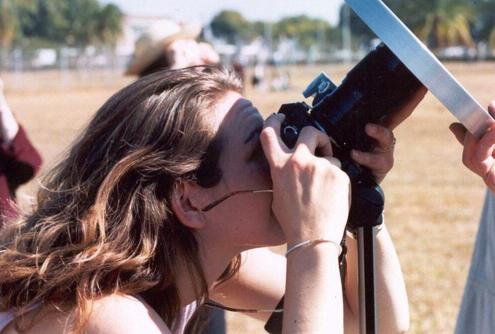Eclipse Photography
DO NOT use a simple "point and shoot" camera aimed at the Sun, as
looking at the Sun through the viewfinder will blind you. Rather use it to
photograph the scene around you as the eclipse develops.
For the same reason take great care with a digital camera or video
camera. Also check that the detectors in your digital or video camera will
not be damaged by direct sunlight entering the lens.
To photograph the eclipse itself, use a 35 mm SLR camera, as follows:
- Turn off the flash or put black tape over it
- Use a solar filter when the eclipse is partial
- Do not use a solar filter when the eclipse is total
- Use a lens of 200 mm to 1000 mm focal length for a reasonable image size
- Use fast film such as ISO 400 to minimise the movement of the Sun
during each exposure
- Pre-focus the lens at infinity
- Set the camera on a tripod and use a remote release (cable or infrared)

Photographing the partial eclipse, using a 35mm camera and telephoto lens
with a solar filter, mounted on a tripod. The photographer cannot see the
Sun except through the filter, so it is eye-safe.

Photographing the total eclipse, using a 35mm camera and telephoto lens,
mounted on a tripod. A solar filter is NOT needed now. A cable release is
used to stop the camera shaking.
Best practise when photographing people at the eclipse is - don't use
flash during totality! Especially near people photographing the eclipse.
And especially not in their faces and cameras. Best practise is to use
natural light, which is rather brighter than the light from a full moon.
This will typically show the eclipse watchers silhouetted against the
"sunset" around the horizon.
More detailed advice on photography is available from the weblinks given
at the end of these webpages.
www.hartrao.ac.za/other/eclipse2002/ecl_photo.html
Last updated 2002/11/26 by
mike@hartrao.ac.za
.
since 2002/10/08


